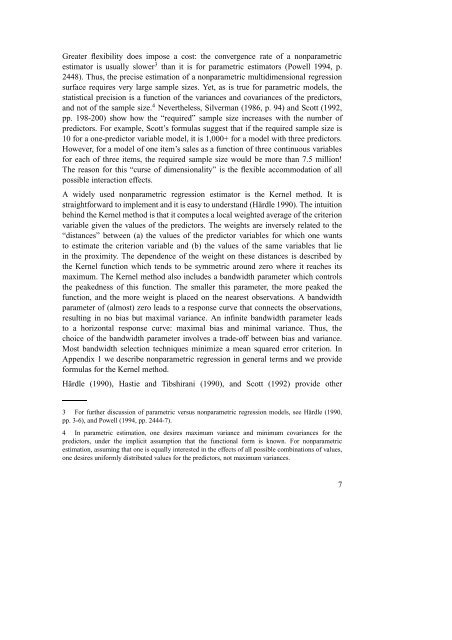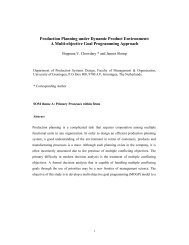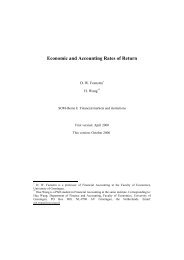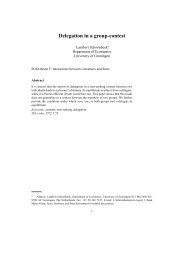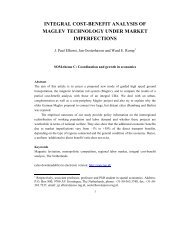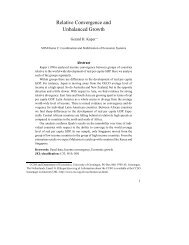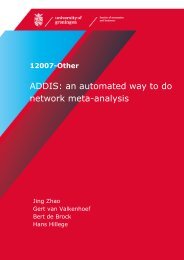Semiparametric Analysis to Estimate the Deal Effect Curve
Semiparametric Analysis to Estimate the Deal Effect Curve
Semiparametric Analysis to Estimate the Deal Effect Curve
Create successful ePaper yourself
Turn your PDF publications into a flip-book with our unique Google optimized e-Paper software.
Greater flexibility does impose a cost: <strong>the</strong> convergence rate of a nonparametric<br />
estima<strong>to</strong>r is usually slower3 than it is for parametric estima<strong>to</strong>rs (Powell 1994, p.<br />
2448). Thus, <strong>the</strong> precise estimation of a nonparametric multidimensional regression<br />
surface requires very large sample sizes. Yet, as is true for parametric models, <strong>the</strong><br />
statistical precision is a function of <strong>the</strong> variances and covariances of <strong>the</strong> predic<strong>to</strong>rs,<br />
and not of <strong>the</strong> sample size. 4 Never<strong>the</strong>less, Silverman (1986, p. 94) and Scott (1992,<br />
pp. 198-200) show how <strong>the</strong> “required” sample size increases with <strong>the</strong> number of<br />
predic<strong>to</strong>rs. For example, Scott’s formulas suggest that if <strong>the</strong> required sample size is<br />
10 for a one-predic<strong>to</strong>r variable model, it is 1,000+ for a model with three predic<strong>to</strong>rs.<br />
However, for a model of one item’s sales as a function of three continuous variables<br />
for each of three items, <strong>the</strong> required sample size would be more than 7.5 million!<br />
The reason for this “curse of dimensionality” is <strong>the</strong> flexible accommodation of all<br />
possible interaction effects.<br />
A widely used nonparametric regression estima<strong>to</strong>r is <strong>the</strong> Kernel method. It is<br />
straightforward <strong>to</strong> implement and it is easy <strong>to</strong> understand (Härdle 1990). The intuition<br />
behind <strong>the</strong> Kernel method is that it computes a local weighted average of <strong>the</strong> criterion<br />
variable given <strong>the</strong> values of <strong>the</strong> predic<strong>to</strong>rs. The weights are inversely related <strong>to</strong> <strong>the</strong><br />
“distances” between (a) <strong>the</strong> values of <strong>the</strong> predic<strong>to</strong>r variables for which one wants<br />
<strong>to</strong> estimate <strong>the</strong> criterion variable and (b) <strong>the</strong> values of <strong>the</strong> same variables that lie<br />
in <strong>the</strong> proximity. The dependence of <strong>the</strong> weight on <strong>the</strong>se distances is described by<br />
<strong>the</strong> Kernel function which tends <strong>to</strong> be symmetric around zero where it reaches its<br />
maximum. The Kernel method also includes a bandwidth parameter which controls<br />
<strong>the</strong> peakedness of this function. The smaller this parameter, <strong>the</strong> more peaked <strong>the</strong><br />
function, and <strong>the</strong> more weight is placed on <strong>the</strong> nearest observations. A bandwidth<br />
parameter of (almost) zero leads <strong>to</strong> a response curve that connects <strong>the</strong> observations,<br />
resulting in no bias but maximal variance. An infinite bandwidth parameter leads<br />
<strong>to</strong> a horizontal response curve: maximal bias and minimal variance. Thus, <strong>the</strong><br />
choice of <strong>the</strong> bandwidth parameter involves a trade-off between bias and variance.<br />
Most bandwidth selection techniques minimize a mean squared error criterion. In<br />
Appendix 1 we describe nonparametric regression in general terms and we provide<br />
formulas for <strong>the</strong> Kernel method.<br />
Härdle (1990), Hastie and Tibshirani (1990), and Scott (1992) provide o<strong>the</strong>r<br />
3 For fur<strong>the</strong>r discussion of parametric versus nonparametric regression models, see Härdle (1990,<br />
pp. 3-6), and Powell (1994, pp. 2444-7).<br />
4 In parametric estimation, one desires maximum variance and minimum covariances for <strong>the</strong><br />
predic<strong>to</strong>rs, under <strong>the</strong> implicit assumption that <strong>the</strong> functional form is known. For nonparametric<br />
estimation, assuming that one is equally interested in <strong>the</strong> effects of all possible combinations of values,<br />
one desires uniformly distributed values for <strong>the</strong> predic<strong>to</strong>rs, not maximum variances.<br />
7


